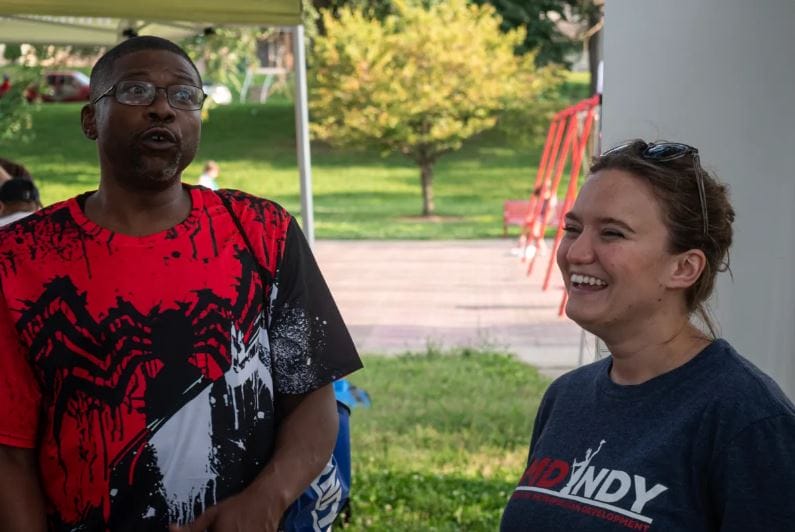Indy holds westside block party to launch community resources initiative
INDIANAPOLIS (MIRROR INDY) — Indianapolis has launched an effort to learn about what types of resources residents in three neighborhood blocks across the city need and how best to provide them.
The Road to Resources initiative will gather data from residents and community organizations and provide the neighborhoods with resources from multiple agencies to improve safety and infrastructure.
The locations were chosen using crime and infrastructure data from several city agencies. They are the neighborhood block to the southeast of the intersection of 10th Street and North Rural Street on the near east side, the neighborhood block to the northeast of the intersection of East 21st Street and North Arlington Avenue on the east side and the neighborhood block northeast of the intersection of Morris Street and Belmont Avenue on the west side.
“What we want to learn from neighbors is what they consider a healthy, thriving and safe neighborhood,” said Brittany Crone, director of community outreach for the Indianapolis Mayor’s Office. “We want to know what already exists here that makes them feel safe and connected, and we also want to know what’s not here that would make them feel safe and connected.”
The city will use the data it collects at the block parties to help city agencies decide how to use their resources effectively.
“We’ll take that information back and connect with all the agency directors in the city and ask them how we can make this happen, what is feasible and put public dollars to work in a different way than how we’ve seen in the past,” said Maggie Adams-McBride, project manager for the Office of the Mayor.
The city kicked off the initiative with a block party featuring multiple city agencies, utility companies and neighborhood organizations July 30 at Rhodius Park in West Indianapolis.
Finding a neighborhood’s needs
The area near Morris Street and Belmont Avenue was chosen due to its infrastructure needs, but the city’s initiative could help drive needed resources to West Indianapolis, a neighborhood which has yet to fully recover from the loss of its manufacturing base.
In the period between World War II and the mid-1980s, West Indianapolis was a neighborhood of plenty.
Thousands of residents were employed at industrial plants right in the neighborhood, like the General Motors plant and the Chrysler Foundry. Many businesses, including grocery stores, pharmacies and bowling alleys, set up shop along West Morris Street to serve workers and their families.
But when those jobs went away, the businesses did, too, and a lot of people living in the neighborhood fell on hard times.
The average family in West Indianapolis now makes about $25,000 less a year than the rest of the city and about $10,000 less a year than the rest of the county. As a result, many families struggle to make ends meet.
At its heart is the Mary Rigg Neighborhood Center, which has helped residents survive and thrive for more than a century by providing access to basic needs, including food and baby supplies, job training, mental health first aid and other support.
The center started as a resource for immigrants who came to work in the industrial plants and meatpacking plants in the neighborhood. It serves the wider community now, and because its staff deals with West Indianapolis residents daily, it has insight into their needs.
“People are really struggling with food insecurity right now,” said Cindy Miers, director of operations for the Mary Rigg Neighborhood Center. “There’s not really a grocery store nearby, and that’s a problem.”
Miers said there’s a Dollar General nearby, but it offers a limited selection of groceries and is at a price point that limits what residents can buy. The grocery stores that exist are miles away from where people live and are difficult to reach on foot, especially when loaded with enough food to feed a family.
Miers believes the city could partner with large businesses to fund a nonprofit grocery store or figure out ways to make it easier for people to travel to and from the grocery stores that already exist.
The center staff’s insight is part of what the city is looking for. The other comes from residents.
Michelle Le Monde, 48, has lived in West Indianapolis most of her life and is concerned about the effect of zoning issues on the neighborhood.
With the $300-million Elanco Animal Health Inc. headquarters and the $10 million West Morris Street Revitalization project nearing completion, the neighborhood could attract future investment. But Le Monde is concerned about commercial development opportunities due to potential zoning changes in parts of the neighborhood.
“We are such an industrial area, that once an area’s zoned to allow a use there’s not much you can do to change that,” she said.
A long-term investment
The city considers the data it collects as part of the initiative the beginning of a long-term investment in the three areas.
“We’re really thinking about this long term,” Adams-McBride said. “We don’t want to come in, invest a bunch of dollars and leave. We want to invest these dollars in the neighborhood and simultaneously see a more lasting sustainability.”
The initiative will hold block parties at the two eastside neighborhoods later this summer. The initiative is scheduled to develop and launch projects based on the data collected later this year.
Mirror Indy reporter Enrique Saenz covers west Indianapolis. Contact him at 317-983-4203 or enrique.saenz@mirrorindy.org. Follow him on X @heyEnriqueSaenz



